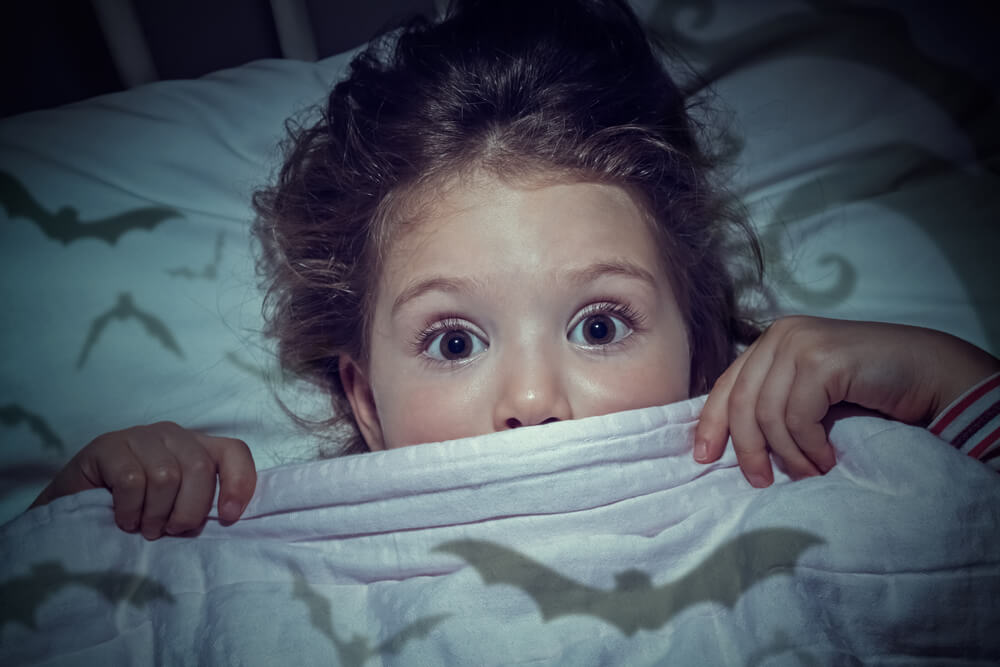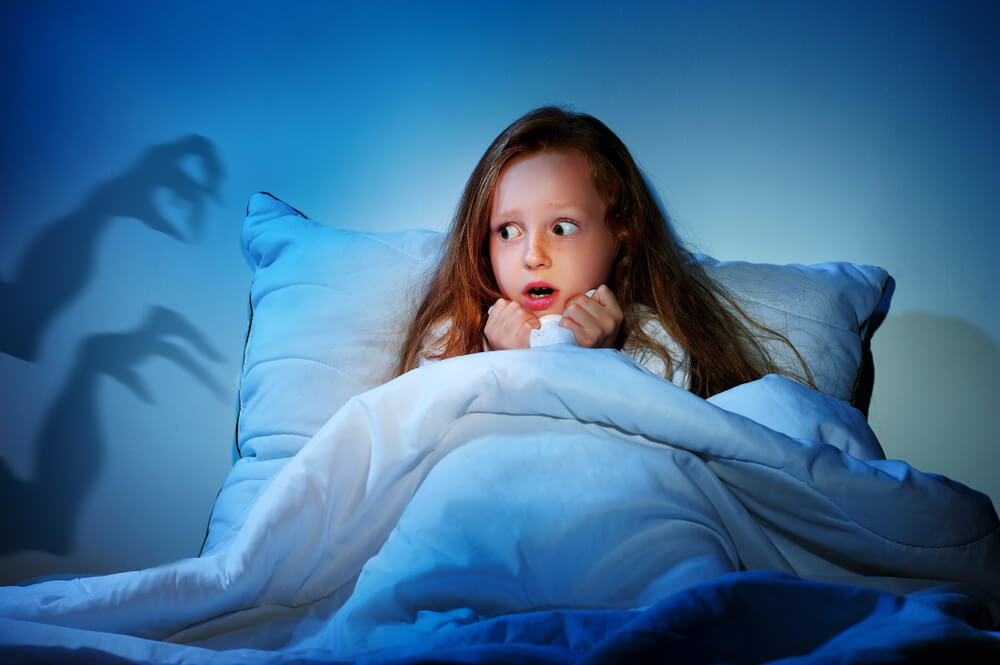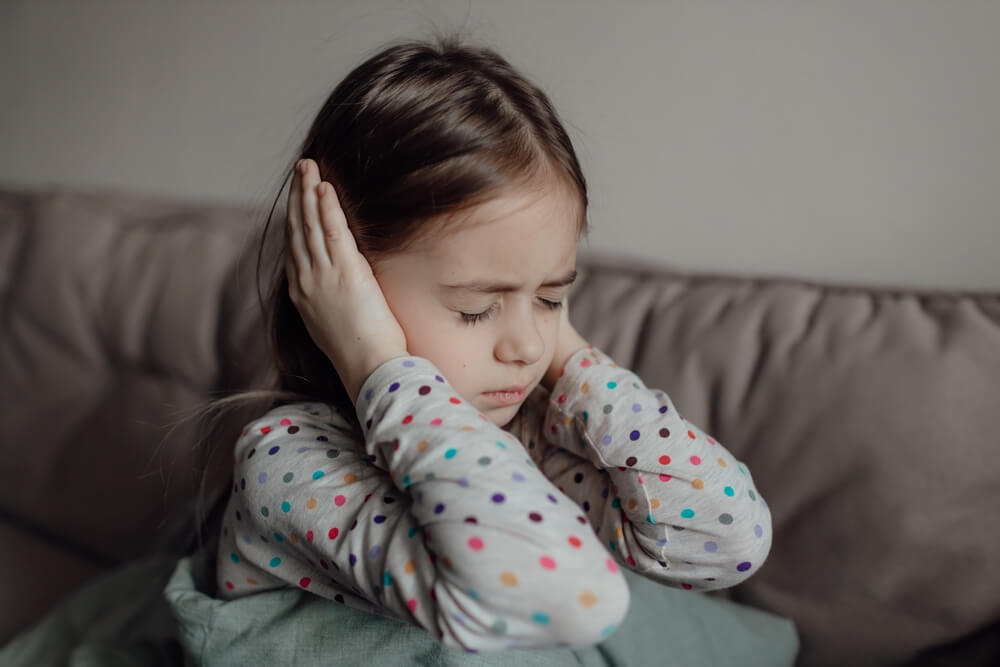“Go Away, Monster Under My Bed!” How to Help a Child With Fear Of Monsters?

Is your child afraid of monsters? While the universal fear of monsters is a normal part of child development, shaped by psychological complexities and cultural influences, it’s not something your child simply has to “deal with.”
Parents often complain, saying, “My child is afraid of monsters and has recurring bad dreams. Can you tell me what to do about that?” This is one of the most popular requests made to psychologists. However, modern films, the Internet, and the availability of information should not be blamed for the prevalence of children’s fears, as ghosts and monsters were there long before the invention of electricity and writing.
It’s no secret that we, as parents, often intentionally or unintentionally create scary stories and pass them on to our kids. But why do we invent these horror stories? How can you help the kids who are scared of them deal with those fears?
Contents:
What are Phasmophobia and Teraphobia?

Kasefoto/Shutterstock.com
It turns out that the fear of monsters under the bed has a certain scientific name—phasmophobia. The meaning of the word phasmophobia, stemming from the Greek words “phasma”—ghost, and “phobia”—fear, according to the dictionary of medical terms, is the obsessive fear of ghosts, goblins, devils, and other imaginary creatures.
Phasmophobia, the fear of ghosts and imaginary creatures, is well-known. But what about Teraphobia? Teraphobia, derived from the Greek words “tera”—monster, and “phobia”—fear, describes the fear of monsters and mythical creatures. So, while phasmophobia pertains specifically to ghosts, teraphobia encompasses a broader spectrum of monstrous entities.
Not all kids will be afraid of the same things—this is an important understanding to have if you’re going to equip your child with fear management strategies. What your child is afraid of will depend largely on the surrounding cultural and social environment. For instance, a modern child living in a big city is not afraid of a goblin; however, after watching the movie “It”, they may begin to be afraid of clowns. A kid living in a large mansion might be worried about a haunted house, while one in an apartment might be worried about home invaders.
Mary arrived at her appointment with her 5-year-old daughter. Her request was the following: the daughter was afraid to go to the swimming pool, saying that she feared being dragged away by a monster that lives in the depths of the water. At the same time, the child has never been in a situation in which she felt like she was drowning. She swims in the river with no problem and loves to do it. However, when I began talking to the mother, details from her childhood began to emerge. “I hate the smell of chlorine in the pool, so my daughter was always taken to her swimming lessons either by my husband or a nanny. In elementary school, PE classes were at the swimming pool instead of the school gym. I didn’t know how to swim, and somehow, on the first lesson, a classmate just pushed me into the water. He later explained to me that this is how his father taught him not to be afraid of the water. The pool was shallow; I could not have drowned, but I still choked on some water in the panic. Since then, I have not re-entered the water, even in the sea, going deeper than above waist level. I signed my daughter up to learn how to swim so that she could overcome my fears,” said the woman.
It is normal for a person of any age to be afraid of what they don’t understand or have not yet experienced. Not being able to find an explanation for what is happening, the psyche “freezes”. This is the root of most anxiety disorders. Nevertheless, it cannot remain in this state for a long time; thus, it clings to the strangest interpretations of what is happening. This is where the belief in ghosts, aliens, poltergeists, haunted houses, the souls of the dead, and hundreds of other phobias stems from.
Most often, the fear of fictional creatures appears in children aged three years and older. During this time, the child begins to feel themselves as an individual who is separate from their parents and is looking for their own explanations for everything that happens around them.
All young children have phasmophobia and/or teraphobia. They have vivid imaginations and an insufficient understanding of the world, which makes them easily suggestible and enables them to have a low degree of critical thinking.
With an increased understanding of the world around the child, most of their fears will gradually disappear. However, some of them may not only stay there but will instead become stronger and develop into serious adult phobias.
How to Understand That a Child Needs Help in Overcoming Their Fear of Monsters? Red Flags

Rawpixel.com/Shutterstock.com
Not every child wants to talk to adults about their fears and phobias. So how can you recognize when a child cannot cope with their common fears on their own, even if they are fictional? Here are some signs of that:
- The child refuses to do what they are used to: they are afraid to stay in the room on their own, they ask not to turn off the light, or refuse to go to school or extracurricular classes on their own.
- They become quiet and antisocial, or even aggressive.
- They are startled by sudden sounds, loud noises, or flashes of light.
- They are suffering from insomnia and nightmares, and cry in their sleep.
- Sometimes, in the most serious cases, enuresis may appear, and the child may begin to bite their nails or pull out their hair.
If you notice at least three of these indicators, it could be a sign that your child is scared of monsters, experiencing extreme fear, and struggling to cope on their own.
What to do if you notice at least three of the indicators named above? Start with talks:
- DO NOT ask: a child may not always be ready to discuss their nighttime fears, especially if they are quite deeply rooted in their minds.
- Tell them what you were afraid of as a child and how these fears turned out to be fake, as well as how you managed to cope with them and who helped you (parents, friends, teachers, etc).
- Explain that monsters on TV are created by computers and that scary stories are written by ordinary people with rich imaginations, etc.
- Provide a night light in the child’s room—this can help alleviate a fear of darkness and provide a more comforting environment for sleep.
When is it worth seeking behavioral therapy for your children’s fears? This is more a question of your condition, rather than the condition of the child. If you don’t feel your own inner strength to work on the matter, or if your child’s fears persist despite providing your child with adequate coping skills, entrust it to a mental health professional.
Where Does the Fear of Ghosts or Monsters Originate From?

Forewer/Shutterstock.com
Psychologists discovered long ago that the mechanism of the appearance of fears and phobias in children and adults is completely different. First, let’s look for reasons why we, as adults, are afraid of fictional or invented matters.
There are no predators to be afraid of in the modern world, as the lookout for food has ceased to be so frightening and dangerous. Yet the functioning of our brain has changed very little, and it is still very much stuck in the past. One of the oldest brain systems is the so-called “reptilian brain”, responsible for basic needs, such as hunger, sleep, and thirst. In order to start performing an action, we need psychic energy, and it is taken from a specific structure located along the entire axis of the brain stem: the reticular formation. It is this formation that sends signals to the level of the reptilian brain.
Our need for survival, which “resides” in the “reptilian brain”, is evolutionarily programmed to seek out danger. This way, when the brain does not see serious problems in reality, it begins to speculate. It is widely known that during war or natural disasters, neuroses, anxiety disorders, and phobias disappear since a person begins fighting for their real survival.
Therefore, when we talk about adults and their fears, everything is pretty clear: the brain generates energy to meet basic needs. When these needs are satisfied, but there is some energy left, the brain does not perceive real dangers as threats; thus, the search for imaginary dangers begins. Children, on the other hand, seek satisfaction of their basic needs primarily from their parents and from other adults that they trust, such as relatives, grandparents, and teachers. Therefore, they draw fears from the people around them.
Let’s now look at the sources of fears and bad dreams in our children.
According to the personal experience of a child therapist working with parents and children, the source of these fears lies in us, the parents, to a large extent. What do we do and why do we do it, so that our children begin to fear certain things?
- We want to be needed by children as protectors. Therefore, we need to watch scary films together with the child, being there for them to cuddle up with us.
- We’re trying to tell them and to warn them of the dangers of the world around them. Therefore, we tell them tales about bad-behaved kids who are taken away by a gray wolf or an evil wizard.
- We want to show the difference between good and evil. Therefore, we read books where a good hero defeats a bad monster.
- We don’t know how to explain certain things or provide answers to some complex questions. Therefore, we tell urban legends and paranormal stories.
- We think scary movies are fun and are trying to inspire more emotions in our children. For the same reason, we dress up for Halloween and make some spooky jokes.
- We devalue the experiences of our children. Therefore, we ridicule their fears and make ironic comments about their fantasies.
- Last but not least, we are anxious. We may suffer from anxiety as a result of various matters, such as mortgage payments, health status, income level, and so on. Nevertheless, our children can only sense that we are worried without an explanation, which can exacerbate existing anxiety disorders.

Tatevik Bagdasaryan/Shutterstock.com
Why is it enough for some children to catch a glimpse of a scary image in a movie and start having nightmares, whilst others can calmly watch horror films and eat popcorn? The simplest explanation is the level of emotionality and impressionability of each particular child. The emotional maturity and stability of a child depend on the calmness and poise of the adults who surround them.
Peter turned to a psychologist with a request to help him deal with the fears of his nine-year-old son. A well-rounded, sociable, and cheerful boy suddenly started to be afraid to go to school on his own about two years ago, despite it being located only two blocks away from their house. “My wife and I both work, our parents live far away, and we cannot afford to hire a nanny just to pick up and drop off the child. Jack has been going to school by himself since the second grade, and was proud of his independence when this came out of nowhere”, shared Peter.
We have been looking for the causes of the boy’s sudden fears for some time, until I asked the boy’s mother to come to see me as well. “My husband was very proud of the fact that Jack is an easygoing child who easily finds common ground with adults and his peers. However, it was worrying me. After all, there can be so many dangerous and unpleasant people around. At his age, he still cannot decide for himself whether a person is good or bad. I just wanted to show my son that he doesn’t have to be so open!” The woman suddenly started crying. Of course, during behavioral therapy, we could not tell the child that their mother was wrong. Nevertheless, we began to work with the mother’s fears in the first place and asked Jack to help us. The little child, together with me, as a professional, was teaching his mother to trust the world.
Protect your child from any danger, no matter where they are! Listen to the sound around, see their route on the map, and receive an instant SOS signal with the Findmykids app.
How to Help the Child Stop Fearing an Imaginary Threat?

Andrey Sayfutdinov/Shutterstock.com
Is it possible to prevent childhood fears from turning into phobias and nightmares? Undoubtedly. Let’s take a look at some basic techniques.
Preventative Measures
First, a message to parents: get your fears under control! This is the first and most important rule. Our panicked desire to protect our children from the outside world can automatically turn into trust issues and nightmares. No matter how hard it is, speak to them and explain everything calmly, no matter what happens.
Do not rush to tell them scary stories, especially if your child is very emotional by nature. In this case, horror movies and stories with frightening villains will have to wait until middle school, especially if managing a fear of the dark.
Make fun of the monsters, not the child’s fears. When your son or daughter comes to you and tells you that they are afraid of ghosts, darkness, vampires, etc, do not dismiss their complaints. Take the time and explain to them why these monsters simply cannot exist. Discuss who invented them and how, and provide some scientific proof, having studied the topic by yourself in the first place, and then presenting it to the child in an easy-to-understand format.
Ask yourself—is your content accurate? Providing accurate information is important to build a foundation of trust, so that when you discuss their fears, they will know they can rely on you.
How to Deal With an Existing Fear of Monsters and Ghosts?

ajlatan/Shutterstock.com
If the fears and phobias of monsters, zombies, and other fictional evil spirits are already there, how can you help your child deal with them?
- Take the child’s fears seriously. Leave the lights on if they are afraid of the dark. Look in the closet and under the bed if the child fears that monsters can crawl out of there. Show that you care and that you are ready to protect them from anything that they are afraid of, whether it’s real or stems from irrational fears. Use “monster spray” (you can make your own out of lavender essential oil) to help scare the monster away at night.
- Be honest. You will have to find real answers to difficult questions about the fact that the grandmother died and will not come again, or how to protect themselves from a pedophile or aggressor, as well as where the Earth came from, and to hundreds of other questions.
- The “Boggart” method. Together with your child, watch the part of the Harry Potter films where the teacher invites the students to call their biggest nightmare out of the closet, and the only way to deal with it is through laughter. Together with your child, draw or describe their fears in the most ridiculous way, and laugh as loudly as possible.
- Be rational. If the child is afraid of characters from horror films, find photos or videos that show how these monsters were created with the use of makeup, costumes, and scenery. If the child is afraid of ghosts, use science to help justify the nature of paranormal phenomena.
- Give your child a protective object. Accept the fact that you cannot always be there to protect your child from fears. This means that they will need something that will provide a feeling of peace and security, such as a favorite toy, a stuffed animal, a bracelet, a special blanket, or anything else that they can hold or stroke, allowing them to calm down. Tell them that the teddy bear will scare away the monsters, or that the keychain is a magical protector against monsters and scary creatures. Again, some parents even create “monster spray” when putting their child to bed, which can also be just a harmless water spray in a fancy spray bottle to help their child feel safer at night. This is a powerful visualization tool to boot!
- Comforting routines can play a significant role in alleviating nighttime fears. Establishing a consistent bedtime routine, such as reading a story, cuddling with a favorite toy, or listening to calming music, can help create a sense of security.
- Consider techniques like exposure therapy or deep breathing to gradually introduce them to their fears in a controlled and supportive environment.
It is normal for both adults and children to be afraid. However, it is important to remember that you control your fears and that they don’t control you. No matter how old you are, whether it is three years old, 15, or 45, you are not alone in your fight against the most terrible monsters. There will always be someone nearby who will say, “Look, this monster is just a computer effect, no one is hiding under the bed, and walking home together isn’t scary at all”!
While family therapy can help your child get over their fear of monsters, in most cases, all it takes is a conversation. Having a sense of control over their fears can help children navigate their nighttime fears and anxieties more effectively.
FAQs

MT PhotoLife/Shutterstock.com
What are the fears of a 7-year-old?
By the age of 7, most children will know the difference between real and pretend. It follows that their fears are about things that could happen, ranging from burglary, kidnapping, facing a scary animal, and things they see in the media, such as dangerous storms or war.
The first thing a parent can do to help is show the child that they take their fear seriously.
What is the phobia of monsters called?
Teraphobia is a common childhood fear of monsters. Originating from ancient Greek τέρας (téras, “monster”).
What is a fear of monsters?
A fear of monsters, often experienced by children, is a common anxiety disorder that can stem from an overactive imagination, exposure to scary movies, or fear of the unknown. Children may believe in mythical creatures like a “monster in the closet” or under the bed, leading to sleep disturbances and heightened anxiety at night.
What is Megalohydrothalassophobia?
It is the fear of large objects underwater—both living and not, e.g., whales and large structures.
What is Teratophobia?
Teratophobia is a rare, irrational fear of monsters, and can sometimes specifically refer to the fear of giving birth to a child with a deformity (who is, in effect, a “monster”).
What is Hippopotomonstrosesquippedaliophobia, the fear of?
Hippopotomonstrosesquippedaliophobia is the fear of long words. While it may sound humorous, it is a real anxiety disorder that can cause significant distress. People with this phobia may avoid situations where they might encounter long or complex words, leading to social isolation or difficulty in academic or professional settings.
What phobia is athazagoraphobia?
Athazagoraphobia is the fear of being forgotten or ignored, or the fear of forgetting someone or something important. This phobia can lead to feelings of loneliness, social isolation, and difficulty maintaining relationships.
The picture on the front page: Morrowind/Shutterstock.com
Проверьте электронный ящик



















